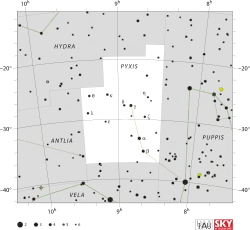Eta Pyxidis
Eta Pyxidis (η Pyxidis) is a solitary,[10] white-hued star in the southern constellation of Pyxis. It is faintly visible to the naked eye with an apparent visual magnitude of +5.27.[2] Based upon an annual parallax shift of 14.07 mas as seen from Earth,[1] this star is located around 232 light years from the Sun. At that distance, the visual magnitude of the star is diminished by an extinction factor of 0.07 due to interstellar dust.[5]
 | |
| Observation data Epoch J2000.0 Equinox J2000.0 (ICRS) | |
|---|---|
| Constellation | Pyxis |
| Right ascension | 08h 37m 52.15248s[1] |
| Declination | −26° 15′ 18.0063″[1] |
| Apparent magnitude (V) | +5.27[2] |
| Characteristics | |
| Spectral type | A0 V[3] |
| B−V color index | −0.04[2] |
| Astrometry | |
| Radial velocity (Rv) | 31.0±4.2[4] km/s |
| Proper motion (μ) | RA: −24.49[1] mas/yr Dec.: −13.02[1] mas/yr |
| Parallax (π) | 14.07 ± 0.21[1] mas |
| Distance | 232 ± 3 ly (71 ± 1 pc) |
| Absolute magnitude (MV) | +0.90[5] |
| Details | |
| Mass | 2.51±0.01[6] M☉ |
| Luminosity | 42[7] L☉ |
| Surface gravity (log g) | 4.33[8] cgs |
| Temperature | 11,614±395[8] K |
| Rotational velocity (v sin i) | 238[6] km/s |
| Age | 67[8] Myr |
| Other designations | |
| Database references | |
| SIMBAD | data |
This is an A-type main-sequence star with a stellar classification of A0 V.[3] It is young with an age of around 67[8] million years and is spinning rapidly with a projected rotational velocity of 238 km/s.[6] The star has 2.51[6] times the mass of the Sun and is radiating 42[7] times the Sun's luminosity from its photosphere at an effective temperature of around 11,614 K.[8]
References
- van Leeuwen, F. (2007), "Validation of the new Hipparcos reduction", Astronomy and Astrophysics, 474 (2): 653–664, arXiv:0708.1752, Bibcode:2007A&A...474..653V, doi:10.1051/0004-6361:20078357, S2CID 18759600.
- Johnson, H. L.; et al. (1966), "UBVRIJKL photometry of the bright stars", Communications of the Lunar and Planetary Laboratory, 4 (99): 99, Bibcode:1966CoLPL...4...99J.
- Houk, Nancy; Smith-Moore, M. (1978), Michigan catalogue of two-dimensional spectral types for the HD stars, 4, Ann Arbor: Dept. of Astronomy, University of Michigan, Bibcode:1988mcts.book.....H.
- de Bruijne, J. H. J.; Eilers, A.-C. (October 2012), "Radial velocities for the HIPPARCOS-Gaia Hundred-Thousand-Proper-Motion project", Astronomy & Astrophysics, 546: 14, arXiv:1208.3048, Bibcode:2012A&A...546A..61D, doi:10.1051/0004-6361/201219219, S2CID 59451347, A61.
- Gontcharov, G. A. (November 2012), "Spatial distribution and kinematics of OB stars", Astronomy Letters, 38 (11): 694–706, arXiv:1606.09028, Bibcode:2012AstL...38..694G, doi:10.1134/S1063773712110035, S2CID 119108982.
- Zorec, J.; Royer, F. (January 2012), "Rotational velocities of A-type stars. IV. Evolution of rotational velocities", Astronomy & Astrophysics, 537: A120, arXiv:1201.2052, Bibcode:2012A&A...537A.120Z, doi:10.1051/0004-6361/201117691, S2CID 55586789.
- McDonald, I.; et al. (2012), "Fundamental Parameters and Infrared Excesses of Hipparcos Stars", Monthly Notices of the Royal Astronomical Society, 427 (1): 343–57, arXiv:1208.2037, Bibcode:2012MNRAS.427..343M, doi:10.1111/j.1365-2966.2012.21873.x, S2CID 118665352.
- David, Trevor J.; Hillenbrand, Lynne A. (2015), "The Ages of Early-Type Stars: Strömgren Photometric Methods Calibrated, Validated, Tested, and Applied to Hosts and Prospective Hosts of Directly Imaged Exoplanets", The Astrophysical Journal, 804 (2): 146, arXiv:1501.03154, Bibcode:2015ApJ...804..146D, doi:10.1088/0004-637X/804/2/146, S2CID 33401607.
- "eta Pyx". SIMBAD. Centre de données astronomiques de Strasbourg. Retrieved 2017-07-16.
- Eggleton, P. P.; Tokovinin, A. A. (September 2008), "A catalogue of multiplicity among bright stellar systems", Monthly Notices of the Royal Astronomical Society, 389 (2): 869–879, arXiv:0806.2878, Bibcode:2008MNRAS.389..869E, doi:10.1111/j.1365-2966.2008.13596.x, S2CID 14878976.
